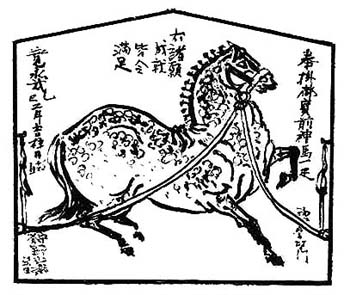|
||
 |
||
Literary records suggest the existence of ema offerings as early as the Heian period (cf. KONJAKU MONOGATARI ¡Ì¨ê; 11c), but the custom probably goes further back. Some 12c and 13c handscrolls depict small ema, most often with the traditional horse motif koema ¬Gn.
In the late 15c, subject matter expanded to include a wide variety of themes. Around this time wealthy patrons began to present large-size ema, ooema åGn which were proudly displayed in an ema hall *emadou Gn° in the shrine precincts. Many ooema from the late Muromachi to Edo periods were signed and dated, thus serving as important biographic data as well as interesting examples of artistic styles of the time. Well known examples from each period include: ema showing Sacred Horses Shinme-zu _n} by Kanou Motonobu ëì³M (1476-1559) in Kamo Jinja êÎ_Ð, Hyougo prefecture; The Thirty-six Immortal Poets Sanjuurokkasen-zu O\ZÌå} by Iwasa Matabee Ⲻq (1578-1650) in Toushouguu Æ{, Saitama prefecuture; and the ema depicting courtesans, painted for Kotohiraguu àä {, Kagawa prefecture by Katsukawa Shunshou ìtÍ (1726-93). Modest size koema created by artisans are the type found for sale today at shrines and some temples. Usually they are illustrated on one side with either a design related to the shrine or an image of its deity. On the back, a blank space is provided for worshippers to inscribe their wish or a note of thanks to the gods. Most follow traditional format and are rectangular with a roof-like shape above and a knot to tie them to a rack or pillar.

@
(C)2001 Japanese Architecture and Art Net Users System.@No reproduction or republication without written permission.
fÚÌeLXgEÊ^ECXgÈÇASÄÌRec̳f¡»E]ÚðֶܷB

